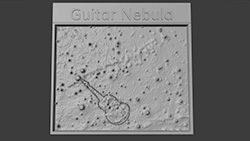CXC Home | Search | Help | Image Use Policy | Latest Images | Privacy | Accessibility | Glossary | Q&A
1
X-ray & Optical Images of Guitar NebulaCredit: X-ray: NASA/CXC/Stanford Univ./M. de Vries et al.; Optical: (Hubble) NASA/ESA/STScI and (Palomar) Hale Telescope/Palomar/CalTech; Image Processing: NASA/CXC/SAO/L. Frattare
The guitar shape in the “Guitar Nebula” comes from bubbles blown by particles ejected from the pulsar through a steady wind as it moves through space. Images from Chandra taken in 2000, 2006, 2012 and 2021 have been combined with a single image in optical light from Palomar. X-rays from Chandra show a filament of energetic matter and antimatter particles, about two light-years long, blasting away from the pulsar (seen as the bright white dot). The movie shows how this filament has changed over two decades. An inset shows a closeup of the “guitar head” from NASA’s Hubble Space Telescope also changing over time from 1994-2021.
2
3D Printable Files: Guitar Nebula (3D Print Credit: NASA/CXC/A. Jubett, using software by Tactile Universe/N. Bonne & C. Krawczyk & Blender)
This tactile plate is a physical relief map based on the intensity of Chandra X-ray and Palomar optical data, featuring what can be described as a giant flame-throwing guitar floating in space.
The guitar shape appears at our lower left, with the neck of the instrument pointing toward our upper left. The guitar shape is ghostly and soft in texture, resembling a wispy cloud on a dark night. At the end of the neck, the guitar’s headstock comes to a sharp point that lands on a prominent dot. This dot is a pulsar, and the guitar shape is a hydrogen nebula. The nebula was formed when particles being ejected by the pulsar produced a cloud of bubbles. The bubbles were then blown into a curvy guitar shape by a steady wind. The guitar shape is undeniable, and is enhanced by an added, thin raised outline.
The pulsar, known as PSR B2224+65, has also released a long filament of energetic matter and antimatter particles approximately 12 trillion miles long. The X-ray blast shoots from the large dot at the tip of the guitar’s headstock, all the way out to our upper righthand corner. The blast resembles a streak of raised dots, most of which fall in a straight, densely packed line.
The guitar shape appears at our lower left, with the neck of the instrument pointing toward our upper left. The guitar shape is ghostly and soft in texture, resembling a wispy cloud on a dark night. At the end of the neck, the guitar’s headstock comes to a sharp point that lands on a prominent dot. This dot is a pulsar, and the guitar shape is a hydrogen nebula. The nebula was formed when particles being ejected by the pulsar produced a cloud of bubbles. The bubbles were then blown into a curvy guitar shape by a steady wind. The guitar shape is undeniable, and is enhanced by an added, thin raised outline.
The pulsar, known as PSR B2224+65, has also released a long filament of energetic matter and antimatter particles approximately 12 trillion miles long. The X-ray blast shoots from the large dot at the tip of the guitar’s headstock, all the way out to our upper righthand corner. The blast resembles a streak of raised dots, most of which fall in a straight, densely packed line.
Return to: NASA's Chandra, Hubble Tune Into 'Flame-Throwing' Guitar Nebula (November 20, 2024)















